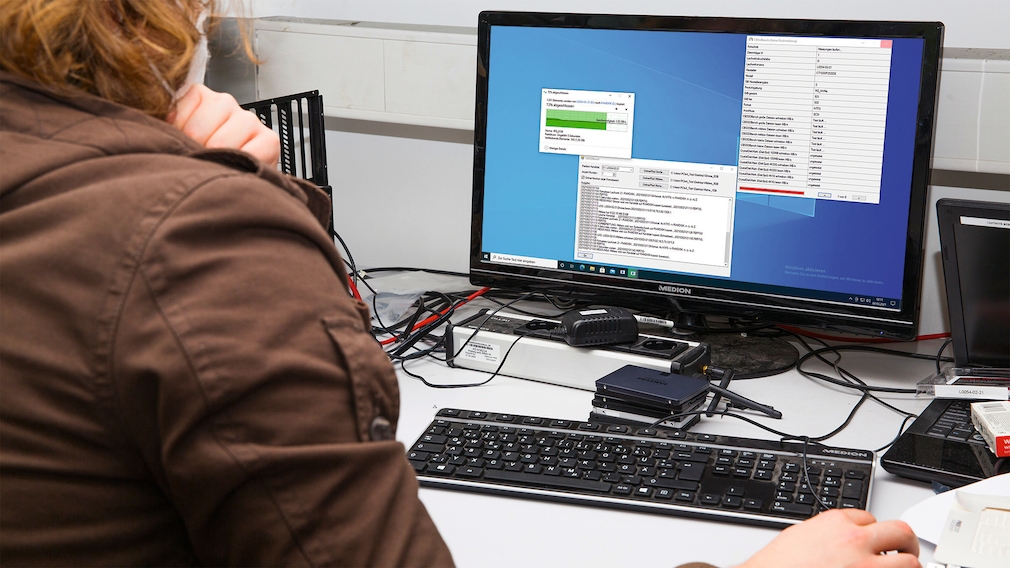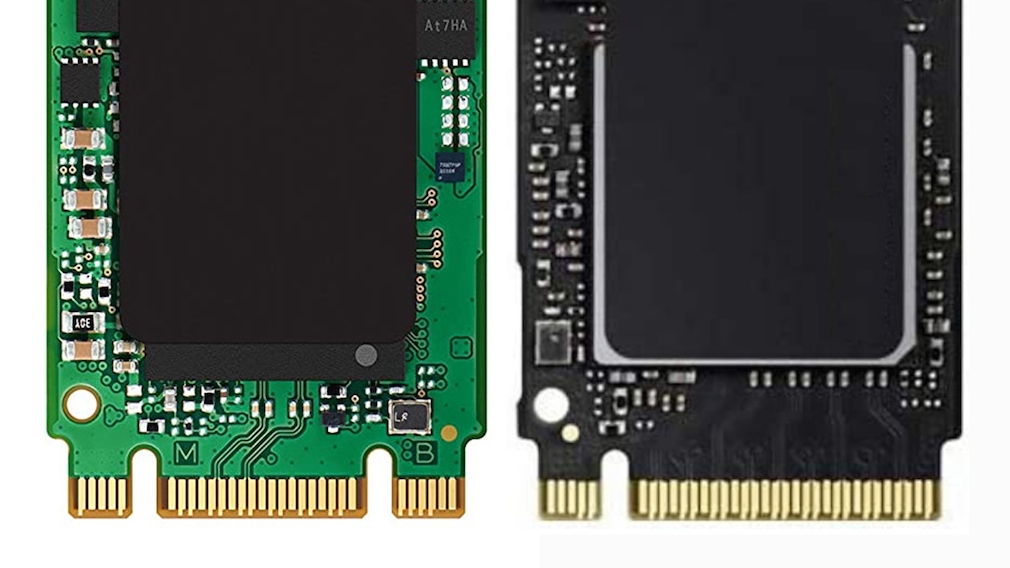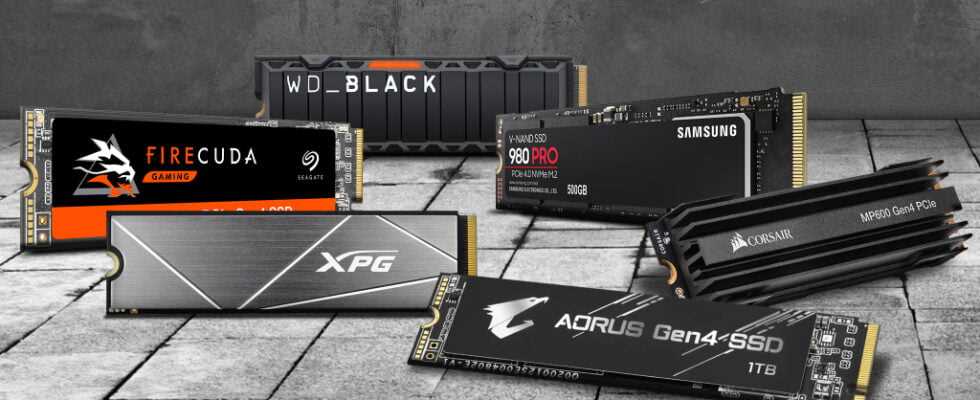If you still have a hard drive in your PC or notebook today, you are working with the handbrake on: It takes an eternity until the computer is ready to start, programs are only ready for use in minutes, and saving edited photos and videos takes a lot of time. Computers with SSDs do such tasks much faster. But SSD is not just SSD. They are available as classic 2.5-inch devices and in M.2 format with a SATA connection. The M.2 SSDs the size of chewing gum strips are also available with a fast PCI Express 3.0 connection – and with super-fast PCI Express 4.0 technology. COMPUTER BILD tested the latest PCI Express 4.0 SSDs.
Test winner and price tip: Crucial P5 Plus 1TB
This is how COMPUTER BILD tests M.2 SSDs
COMPUTER BILD generally tests M.2 SSDs with a PCI Express 4.0 connection in its in-house laboratory. This is what the individual tempo measurements look like:
The same conditions for everyone: COMPUTER BILD tested every SSD in the same test system, regardless of whether the tested M.2 SSDs with PCIe 4.0 connection or 2.5-inch SSDs.
Read and write
In the first test, the M.2 SSDs have to copy data. To ensure that the measurement is practical, the test candidates transfer data in different sizes: small text files, medium-sized music titles and photos as well as huge video files. The test candidates work in both directions. They write the data to the M.2 SSDs and copy them to another storage (“Read”). COMPUTER BILD uses the “Crystal Disk” test program to measure the maximum sustained transfer rate. The determined values show the speed with which the SSDs read and write data over a longer period of time.
access times
The laboratory measures the access time with the “Crystal Mark” program. It indicates how quickly the M.2 SSD finds stored data. The files are often distributed in fragments on the SSD. The access time is specified in milliseconds. The lower the value, the better.

The speed measurements of M.2 SSDs with a PCIe 4.0 connection are largely carried out in an automated test procedure.
program acceleration
But M.2 SSDs not only copy data much faster than old hard drives, they also accelerate the start of Windows, programs and games. To do this, the M.2 SSDs must be able to perform the highest possible number of read and write operations per second – in technical jargon IOPS, which stands for “Input/Output Operations Per Second”: the higher the IOPS number, the better. Good M.2 SSDs can easily do more than half a million reads and writes per second these days. For comparison: Classic hard drives only manage a few hundred IOPS at best.
Pros and cons of SSDs
In addition to a high speed, SSDs offer other advantages:
- Quietly: Since they have no mechanical components, they work completely silently.
- Robust: SSDs are more durable than hard drives with their fast-hopping write and read heads.
- Light and economical: The accumulators are lighter and require less energy. In this way, they not only make notebooks faster, but also lighter – and at the same time extend battery life. The tested Aldi notebook managed four hours without a socket in the test with a hard drive, and a good quarter of an hour longer with an SSD.

One notch less makes the difference: M.2 SSDs are also available with slower SATA technology, as many 2.5-inch SSDs use. You can recognize SATA M.2 SSDs by two notches (in the picture on the left), those with the faster PCI Express 3.0 or PCI Express 4.0 connector only have one notch (in the picture on the right).
SSD test: These differences exist
However, the designation SSD alone says nothing about the type or even the speed – these three types are currently common:
- M.2 SSDs (PCIe 3.0): The M.2 SSDs with PCI Express 3.0 connection tested here are only as big as a stick of chewing gum. Notebook and PC manufacturers build them into many new computers. A x4 PCI Express 3.0 slot is required. The theoretical maximum speed: 3,938 megabytes per second.
- M.2 SSDs (PCIe 4.0): The latest SSD generation tested here looks confusingly similar to the PCIe 3.0 models. They are also the size of a stick of chewing gum, the connection looks exactly the same. The difference: A faster controller works in these SSDs and significantly more data can be transferred via the interface – theoretically up to 7,877 megabytes per second are possible via the x4 slot. Requirement: The mainboard of the PC or notebook has a fast PCI Express 4.0 slot. Because the new SSDs are backwards compatible, they also work in a PCI Express 3.0 slot, but only with the corresponding speed.
- 2.5 inch SSDs: Classic 2.5-inch SSDs are ideal for retrofitting in older PCs and notebooks. The design corresponds to that of 2.5-inch hard drives, as do the connections. 2.5-inch SSDs transfer data via SATA socket (SATA III version) with theoretically up to 750 megabytes per second.
This is important to consider before you buy!
Compared to the previous version PCI Express 3.0, the 4.0 version transports twice as much data via the same slot with four lines (x4) suitable for M.2 SSDs. In theory, this means up to 7.8 gigabytes per second. But the mainboard of the computer must be equipped with the appropriate slot and chipset – otherwise a fast PCI Express 4.0 SSD will only work at PCI Express 3.0 speeds.
Top, but more expensive: WD Black SN850
These systems work with PCIe 4.0
Also great: Samsung 980 Pro
Memory expansion for the PS 5
PCIe 4.0 SSDs: Still potential
PCI Express 4.0 SSDs in the test: conclusion
the Crucial P5 Plus completed the exams at a very high pace. Overall, it’s just as good as its opponents Western Digital SN850 and Samsung Pro 980 Pro. At the time of testing (March 2022), it was significantly cheaper than the SSDs from WD and Samsung with a retail price of around 130 euros. That’s why the test win goes to the Crucial P5 Plus. And because there was no other SSD with a better price-performance ratio in the entire test field, it is also the price tip in this comparison.
What is a PCIe 4.0 SSD?
Compared to the previous version PCI Express 3.0, the 4.0 version transports twice as much data via the same slot with four lines (x4) suitable for M.2 SSDs. In theory, this means up to 7.8 gigabytes per second.
Can you plug PCIe 4.0 SSD into 3.0?
Yes, that works. But the PCIe 4.0 SSD then only transports data at a slower PCI Express 3.0 speed.
Which is better PCIe SSD or SSD?
The fastest SSDs today have a PCI Express 4.0 connector, followed by models with a PCI Express 3.0 connector. Both versions are usually available as chewing gum sticks on large M.2 SSDs. The slowest SSDs transfer their data via the SATA connection – these are available as M.2 and 2.5-inch SSDs.
Does PCIe 4.0 make sense?
Sure, but only if there is a corresponding PCI Express 4.0 slot on the motherboard of the PC or notebook. Or: you want to use the PCI Express 4.0 SSD to expand the storage of the Sony Playstation 5.
What is PCIe 4.0 x4?
This is a PCI Express slot type that is often used for M.2 SSDs with PCIe 4.0 technology. In theory, up to 7.8 gigabytes per second can be transferred via this slot with four lines (x4).
Is PCIe 4.0 backward compatible?
Yes, for example PCI Express 4.0 SSDs in M.2 format can also be installed in the PCI Express 3.0 slot. But the PCIe 4.0 SSD then only transports data at a slower PCI Express 3.0 speed.
What does PCIe 4.0 Ready mean?
This means that PCI Express 4.0-capable components can be installed in this computer. This includes PCIe 4.0 SSDs and newer graphics cards.
